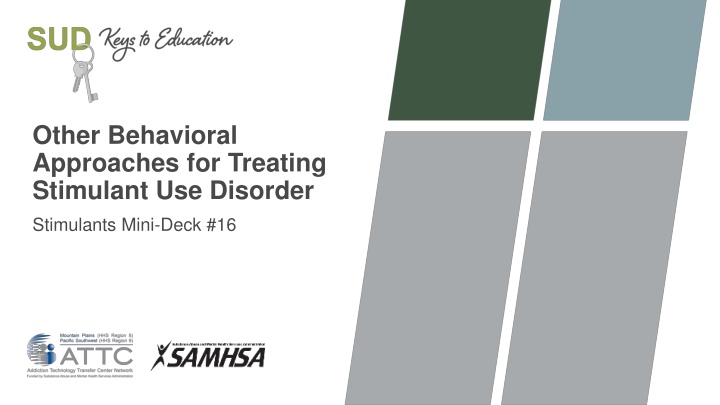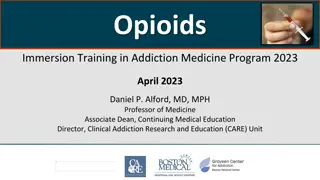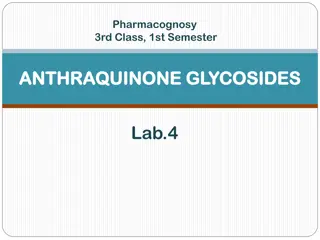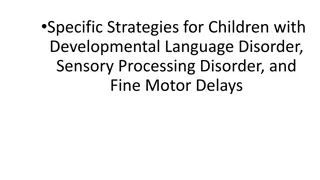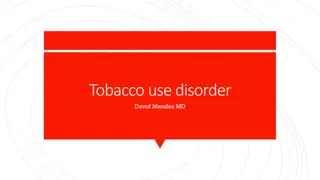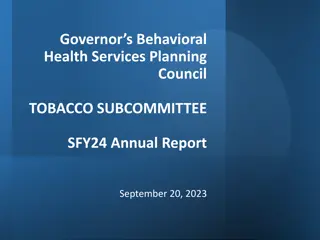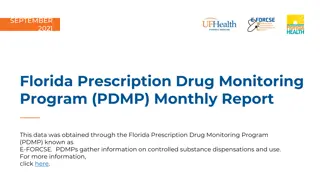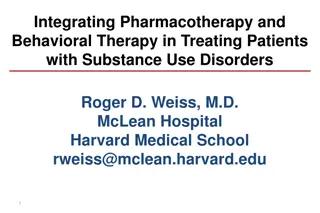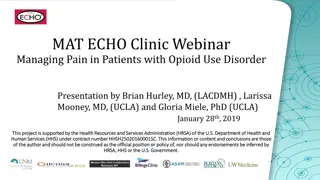Other Behavioral Approaches for Treating Stimulant Use Disorder
Behavioral interventions, such as Cognitive Behavioral Therapy, Motivational Interviewing, and The Matrix Model, play a vital role in addressing stimulant use disorder. These approaches aim to help individuals recognize triggers, develop coping strategies, and enhance motivation for change. With research-backed techniques and skills, clinicians can effectively support individuals struggling with stimulant use.
Download Presentation

Please find below an Image/Link to download the presentation.
The content on the website is provided AS IS for your information and personal use only. It may not be sold, licensed, or shared on other websites without obtaining consent from the author.If you encounter any issues during the download, it is possible that the publisher has removed the file from their server.
You are allowed to download the files provided on this website for personal or commercial use, subject to the condition that they are used lawfully. All files are the property of their respective owners.
The content on the website is provided AS IS for your information and personal use only. It may not be sold, licensed, or shared on other websites without obtaining consent from the author.
E N D
Presentation Transcript
Other Behavioral Approaches for Treating Stimulant Use Disorder Stimulants Mini-Deck #16
Other Behavioral Interventions with Research Support Cognitive Behavioral Therapy/Relapse Prevention Motivational Interviewing The Matrix Model Exercise Mindfulness 2 SOURCES: AshaRani et al., 2020; Stuart et al., 2020; Rawson et al., 2015; Polcin et al., 2014; Rawson et al., 2004.
Cognitive Behavioral Therapy (CBT) Underlying assumption = learning processes play an important role in the development and continuation of a stimulant use disorder CBT attempts to help patients recognize the situations in which they are most likely to use stimulants, avoid these situations when appropriate, and cope more effectively with a range of problems and problematic behaviors associated with substance use. CBT is compatible with a range of other treatments patients may receive, such as pharmacotherapy Also known as Relapse Prevention 3 SOURCES: NIDA, 2016; Carroll, 1998.
What CBT Skills can Clinicians Use when Working with People Who Use Stimulants? Functional analysis and patterns of use Coping with craving Addressing and resolving ambivalence Refusal skills Seemingly irrelevant decisions Planning for emergencies Problem solving skills HIV/HCV risk reduction 4 SOURCES: McHugh et al., 2010; Carroll, 1998; Carroll et al., 1994.
Motivational Interviewing (MI) a directive, client-centered method for enhancing intrinsic motivation for change by exploring and resolving ambivalence (Miller & Rollnick, 2002). a way of being with a client, not just a set of techniques for doing counseling (Miller & Rollnick, 1991). Studies demonstrated reduction in stimulant use with motivational interviewing 5 SOURCES: Polcin et al., 2014; Miller & Rollnick, 2012; Stein et al., 2009.
MI: Principles and Micro-Skills MI Principles: o Express empathy o Develop discrepancy o Address sustain talk and discord o Support self-efficacy MI Micro-Skills (OARS) Open-Ended Questioning Affirming Reflective Listening Summarizing 6 SOURCE: Miller & Rollnick, 2012.
The Matrix Model 16-week intensive outpatient treatment was modestly better than treatment as usual to improve retention and reduce methamphetamine use Therapist functions as teacher and coach Incorporates a variety of approaches: CBT CM MI 12-Step Facilitation Family Involvement Person-Centered Therapy 7 SOURCES: CSAT, 2006; Rawson et al., 2004
Does Exercise Improve Outcomes Post-Treatment? Yes! Fewer exercise patients returned to meth use compared to the education participants at 1-, 3-, and 6-months post-discharge (not statistically significant) Significant interaction found for self-reported meth use and meth urine drug test results lower severity users in the exercise group reported using meth significantly fewer days at the three post-discharge time points than lower severity users in the education group Lower severity users in the exercise group also had a lower percentage of positive urine results at the three time points than the lower severity users in the education group (relationships not seen in higher severity groups) 8 SOURCES: Rawson et al., 2015; Mooney et al., 2014.
The Impact of Exercise on Symptoms of Depression and Anxiety 9 SOURCE: Rawson et al., 2015.
